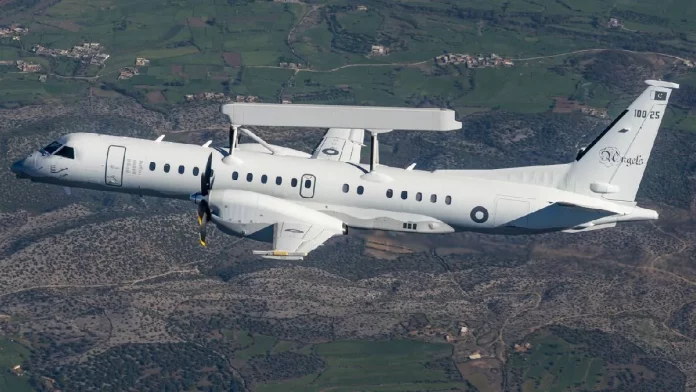SOURCE: RAUNAK KUNDE / NEWS BEAT / IDRW.ORG


Hindustan Aeronautics Limited (HAL) has embarked on a groundbreaking project with the development of the CATS Hunter, a sub-sonic air-launched cruise missile (ALCM) dubbed the “Desi SCALP,” designed to enhance the Indian Air Force’s (IAF) precision strike capabilities. According to sources close to idrw.org, this missile, with a range of 250–350 km, introduces a revolutionary swarm capability, enabling multiple missiles to interact, coordinate targets, and overwhelm enemy air defenses. This marks a significant leap in India’s indigenous defense technology, positioning the IAF to conduct complex, networked aerial operations with unprecedented efficiency.
The CATS Hunter, part of HAL’s Combat Air Teaming System (CATS) program, is a stealthy, sub-sonic cruise missile designed for launch from various IAF fighter jets, including the Su-30MKI, Rafale, and potentially the Tejas Mk1A and Mk2. Powered by the indigenous PTAE-7 turbojet engine, the missile boasts a low-observable design with a minimized radar cross-section (RCS), allowing it to skim just above the surface—evading enemy radar detection through terrain-hugging flight profiles. With a projected range of 250–350 km, the CATS Hunter extends the IAF’s reach, enabling deep strikes into enemy territory while keeping aircraft safely beyond the range of hostile air defenses.
Continue readingSOURCE: AFI


In a significant escalation of tensions between India and Pakistan, a recent report by the Asian News International (ANI) has revealed details of a precision strike conducted by the Indian Air Force (IAF) on the Pakistani air base in Bholari. The attack, executed with cruise missiles, targeted a hangar housing critical assets of the Pakistan Air Force (PAF), including a Saab 2000 Airborne Early Warning and Control (AEW&C) aircraft and at least three to four Western-origin fighter jets. The strike has reportedly caused massive destruction, with the PAF yet to commence debris clearance operations within the devastated hangar.
According to the ANI report, the IAF’s operation was meticulously planned and executed, with real-time monitoring facilitated by Indian satellites and Airborne Warning and Control System (AWACS) aircraft. The precision of the strike underscores India’s advanced military capabilities and its ability to conduct targeted operations against high-value assets.
Continue readingSOURCE: AFI


In a daring and highly coordinated military operation dubbed “Operation Sindoor,” the Indian Air Force (IAF) executed precision strikes that dealt a significant blow to the Pakistan Air Force (PAF), according to a report by the Asian News International (ANI). The operation targeted critical PAF assets, including two Saab 2000 Airborne Early Warning and Control (AEW&C) aircraft, one of which was shot down deep inside Pakistani territory and another destroyed on the ground at the Bholari air base. The strikes, monitored by Indian satellites and AWACS, exposed vulnerabilities in Pakistan’s air defense strategy, particularly its attempt to shield high-value assets by blending them with commercial air traffic.
The ANI report reveals that, fearing India’s advanced S-400 air defense system, the PAF resorted to a desperate tactic during the operation. In an effort to protect its Saab 2000 AEW&C aircraft—critical for airborne surveillance and command—the PAF attempted to position one of these assets among or near commercial airliners operating in Pakistani airspace. This move was likely intended to exploit the presence of civilian aircraft to deter Indian strikes, given the risk of collateral damage. However, the strategy failed spectacularly, as the IAF’s precision capabilities, bolstered by the S-400 system, successfully identified and neutralized one Saab 2000 AEW&C approximately 280-315 kilometers inside Pakistani territory.
Continue readingSOURCE: AFI


In a significant milestone for India’s defense indigenization efforts, Advanced Weapons & Equipment India Ltd. (AW&EIL) handed over the first two indigenously developed Super Rapid Gun Mount (SRGM) barrels to the Indian Navy at its Field Gun Factory (FGK) in Kanpur. The ceremonial handover was presided over by Umesh Singh, Chairman and Managing Director (CMD) of AW&EIL, who presented the barrels to Rear Admiral Rupak Barua, Director General of Naval Armament Inspection (DGNAI). The event took place in the presence of AW&EIL’s Director of Operations, Director of Finance, and Shri K.R. Sinha, Executive Director of FGK, who warmly welcomed the distinguished guests.
The SRGM barrels, critical components of the 76mm naval gun system used on Indian Navy warships, mark a major step toward self-reliance in defense manufacturing. The Field Gun Factory, a key production unit of AW&EIL, was lauded for its efforts in indigenizing this sophisticated weapon system, which is integral to the Navy’s surface warfare capabilities. The 76mm SRGM, known for its high rate of fire and precision, is a cornerstone of naval defense, equipping frontline warships like the Shivalik-class frigates and Delhi-class destroyers.
Continue readingSOURCE: AFI


On May 26, 2025, Defence Minister Rajnath Singh chaired a high-level review meeting in New Delhi with the chairpersons and managing directors of eight Defence Public Sector Undertakings (DPSUs), urging them to enhance production and focus on cutting-edge technologies to strengthen India’s defense preparedness.
The meeting, held amid heightened regional tensions following Operation Sindoor, highlighted the critical role of DPSUs in achieving self-reliance under the Aatmanirbhar Bharat and Make in India initiatives. Singh lauded the industry for its contributions to India’s defense capabilities, particularly during the recent operation, and emphasized the need for accelerated research and development (R&D) to meet the demands of modern warfare.
Continue readingSOURCE: IANS


Russian Ambassador to India Denis Alipov on Wednesday said discussions between India and Moscow on the procurement of more S-400 air defence systems are “ongoing” as both countries continue to solidify the special and privileged strategic partnership.
In an exclusive chat with IANS, Mr Alipov, while citing various reports on Operation Sindoor, termed the performance of the S-400 system and jointly-manufactured BrahMos missiles as “exemplary”.
Continue readingSOURCE: IANS


Pakistan’s Murid air base suffered extensive damages, in May 10 strikes by the Indian Air Force (IAF), destroying not just its buildings and concrete structures but also damaged the underground facility at the vital air station, fresh satellite images revealed on Wednesday.
The high-resolution satellite images shared by the Intel Lab on X, shows a three-metre wide crater, just 30 metres from one of the two entrances at the strategic air base. The damages to buildings and rooftops of structures at the Murid air base, a hub of Pakistani drone and missiles, have already been documented in the satellite imageries, earlier.
Continue readingSOURCE: IANS


Andhra Pradesh Chief Minister Nara Chandrababu Naidu on Wednesday categorically dismissed media reports and political allegations suggesting that he sought the relocation of the Hindustan Aeronautics Limited (HAL) facility from Karnataka to his state.
Speaking at the Mahanadu or annual conclave of the Telugu Desam Party (TDP) here, he clarified that his appeal to the Centre was solely focused on establishing a defence manufacturing hub in Andhra Pradesh and not on shifting existing institutions from other states.
Continue readingSOURCE: IANS


Chief of Army Staff (COAS) General Upendra Dwivedi witnessed high-tech demonstrations of indigenous Unmanned Aerial Systems (UAS), Counter-UAS technology, and Loitering Munitions at the Babina Field Firing Ranges in Uttar Pradesh, the Indian Army said on Wednesday.
In a post on X, the Army stated, “General Upendra Dwivedi, COAS, witnessed cutting-edge demonstrations of indigenous UAS, Counter-UAS and Loitering Munitions on 27 May 2025 at Babina Field Firing Ranges.”
Continue readingSOURCE: PTI
)

Chief Minister Omar Abdullah on Wednesday said the April 22 Pahalgam attack has not stalled the conversation around restoration of statehood to Jammu and Kashmir and that he had raised the issue at the recent meeting of NITI Aayog governing council.
“No, not at all. If you were to take out the formal speech that circulated in the NITI Aayog meeting, you will find a categorical mention for return of statehood in that … which was given to the Honourable Prime Minister and all the members of the governing council of the NITI Aayog,” Abdullah told reporters in this tourist resort of north Kashmir, 52 kilometres from Srinagar.
Continue readingSOURCE: PTI
)

After the government decided to carry out a civil defence exercise on Thursday in states and Union Territories adjoining the western border, Haryana, Rajasthan and Punjab on Wednesday postponed the scheduled mock drill.
The Haryana government on Wednesday evening said the civil defence exercise Operation Shield scheduled for Thursday stood postponed following the Union Home Ministry’s directions.
Continue readingSOURCE: IANS


In a move aimed at bolstering self-defence capabilities in Assam’s remote and sensitive areas, the state Cabinet has approved the issuance of arms licences to eligible residents in vulnerable and border regions.
Chief Minister Himanta Biswa Sarma announced the decision on Wednesday, citing Assam’s unique security challenges and geographical vulnerabilities. “Assam is a difficult and sensitive state. We have decided to issue arms licences to eligible individuals living in remote, vulnerable, and border areas. We will encourage original inhabitants and indigenous Indian citizens to apply under the provisions of the Arms Act,” he said.
Continue readingSOURCE: PTI
)

The Delhi High Court on Wednesday refused to entertain a public interest litigation seeking direction to the Centre for the formation of a Gujjar regiment in the Indian Army.
A bench of Chief Justice D K Upadhyaya and Justice Tushar Rao Gedela termed the PIL to be “absolutely divisive” and asked the counsel for the petitioner to do some research before taking up such petitions. Sensing the court’s mood which warned of imposing costs on the litigant, the petitioner’s counsel withdrew the plea.
Continue readingSOURCE: IDRW.ORG


In a significant boost to India’s Light Combat Aircraft (LCA) Tejas Mk1A program, GE Aerospace has reaffirmed its commitment to supply 12 F404-IN20 engines to Hindustan Aeronautics Limited (HAL) by the end of 2025, following a revised delivery schedule. The announcement comes after GE delivered the first of 99 contracted engines on March 25, 2025, with plans to ship two additional engines starting in July, despite a brief agreed-upon pause in the delivery timeline. This development, reported by idrw.org that HAL can operationalize the Indian Air Force’s (IAF) first Tejas Mk1A squadron by year-end, a critical step in addressing India’s dwindling fighter squadron strength.
The F404-IN20 engine, a high-thrust variant tailored for the Tejas Mk1A, is a cornerstone of India’s indigenous fighter jet program. The initial delivery in March 2025 marked the end of a nearly two-year delay, attributed to global supply chain disruptions and the complexities of restarting the F404-IN20 production line, dormant since 2016 after GE fulfilled an earlier order of 65 engines for the Tejas Mk1. The first engine arrived at HAL on April 3, 2025, and with two more engines scheduled monthly from July, GE has committed to delivering a total of 12 engines by December 31, 2025. This includes the initial unit plus 11 additional engines, aligning with HAL’s goal to produce at least eight Tejas Mk1A jets—six fighters and two trainers—sufficient to form the IAF’s first squadron of 18 aircraft.
Continue readingSOURCE: IDRW.ORG


India announced the development of a cutting-edge 81mm Mortar Telemetry Bomb, a non-explosive round designed to revolutionize artillery training and fire-control calibration. Equipped with advanced sensors, this innovative munition captures critical flight data such as velocity, trajectory, and environmental conditions in real time, transmitting the information wirelessly to ground systems. The development, spearheaded by the Defence Research and Development Organisation (DRDO) in collaboration with private industry partners, marks a significant step in India’s push to enhance the precision and effectiveness of its artillery systems.
The 81mm Mortar Telemetry Bomb is fired like a conventional mortar round but serves an entirely different purpose. Instead of delivering an explosive payload, it is embedded with sensors that monitor its flight parameters throughout its trajectory. These sensors track key metrics, including muzzle velocity, angular deviation, and atmospheric effects like wind speed and temperature, which can impact a mortar’s accuracy. The data is transmitted live via a secure telemetry link to a ground-based fire-control system, allowing artillery units to analyze and adjust their firing solutions in real time. This capability is expected to significantly improve the calibration of mortar systems, ensuring greater accuracy during live combat scenarios.
Continue reading